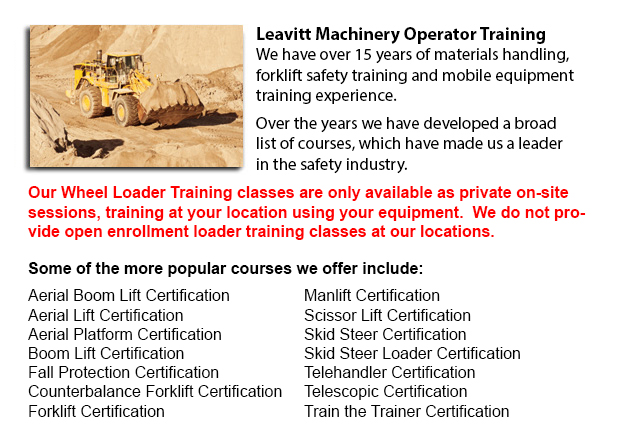
Markham Wheel Loader Operator Training - To be able to pick up significant loads, industrial cranes utilize levers and pulleys. In the past, Roman people utilized cranes to be able to construct big monuments making the origin of these machinery at least two thousand years ago. Many Medieval churches utilized cranes in their construction and the Egyptian people might have relied on them when constructing the pyramids.
The new version of a crane can be either simple or complex, and cranes vary based on their use. Mobile cranes, for example are somewhat simple. A telescopic boom or steel truss mounts its movable platform. A system of pulleys or levers raises the boom and there is normally a hook suspended. These cranes are frequently intended for earthmoving or demolition by changing the hook out with another piece of equipment such as a bucket or wrecking ball. Telescopic cranes have a series of hydraulic tubes which fit together to form the boom. These models could also be mobile.
Traditional wheels, or certain wheels designed for a caterpillar track or railroad track allow these mobile booms to be able to navigate unpaved and uneven surfaces.
Truck mounted and rough terrain cranes are also mobile with outriggers positioned on the truck mounted unit improve stability. However, rough terrain cranes comprise a base which tends to resemble the bottom of a 4-wheel drive. These cranes are equipped so as to operate on rough surface making them perfect in the construction industry for example.
Most often utilized on ports and in railroads, the Gantry crane could transport and unload large containers off ships and trains. Their bases consist of huge crossbeams which run on rails in order to pick up containers from a spot to another. A portainer is a unique type of gantry that transports materials onto and off of ships specifically.
Floating cranes are attached on pontoons or barges and are another important piece of equipment vital to the shipping business. As they are located in water, they are designed for various services including salvaging ships, port construction and building bridges. Floating cranes can handle very heavy weights and containers and similar to portainers, they can likewise unload ships.
Loader cranes are fit onto trailers with hydraulic powered booms so as to load goods onto a trailer. When not being utilized, the jointed sections of the boom could be folded down. This kind of crane can be likewise considered telescopic because one section of the boom could telescope for more versatility.
Stacker cranes are usually found in automated warehouses. They tend to follow an automatic retrieval system and could operate by remote. These cranes are outfitted along with a forklift equipment and could be seen in large automated freezers, obtaining or stacking food. Utilizing this type of system enables workers to remain out of that cold setting.
Tower cranes are frequently the tallest cranes and typically do not have a movable base. They need to be assembled piece by piece. Their base resembles a long ladder along with the boom at right angles to the base. These cranes specialize in the construction of tall structures and are normally connected to the inside of the building itself throughout the construction period.
-
Markham Forklift Certification Schools
Markham Forklift Certification Schools - Forklift Certification is mandatory in North America. Hence, forklift training programs are essential both for businesses and for people seeking jobs in industries as forklift operators. Forklift training focu... More -
Telehandler Training in Markham
Telescopic handlers normally called telehandlers for short, are a very popular piece of heavy construction equipment. They are commonly utilized in the construction and agricultural trades. These machines have maximum reaching capability and can get... More -
Markham Zoom Boom Training
Markham Zoom Boom Training - Zoom Boom Training is designed to train operators on variable reach forklifts. The objectives of the training are to impart an understanding of the physics of the machinery, and to outline the operator's tasks. This progr... More -
Markham Heavy Equipment Ticket
Markham Heavy Equipment Ticket - A heavy equipment operator will utilize different construction machinery, depending upon the nature of the task at hand. The large equipment are constructed to carry out specific tasks in the most efficient method for... More -
Markham Scissor Lift Training
Markham Scissor Lift Training - When operating a scissor lift, they must be utilized competently so as to protect the safety of the other employees inside the workplace and to protect the safety of the machine. Competent operators are trained to driv... More -
Markham Manlift Operator Training
Markham Manlift Operator Training - The aerial lift or manlift is a specialized kind of hydraulic platform which is designed to raise a person vertically giving it an alternate name of a vertical personnel lift. These machines are widely used for a m... More -
Markham Heavy Equipment Training
Markham Heavy Equipment Training - The two most common kinds of heavy equipment training are classed into the categories of machinery; equipment that is fashioned with tracks and those with rubber tires. The tracked vehicle are heavy duty equipment s... More -
Markham Forklift Safety Training
Markham Forklift Safety Training - Those wanting work in industries that utilize forklifts should undergo a forklift safety training course before becoming a certified operator of a forklift. There are various ways to go about getting forklift safety... More

Forklift Certification Markham
TOLL FREE: 1-888-254-6157
Markham, Ontario
forkliftcertificationmarkham.com
Email Us
About Us


